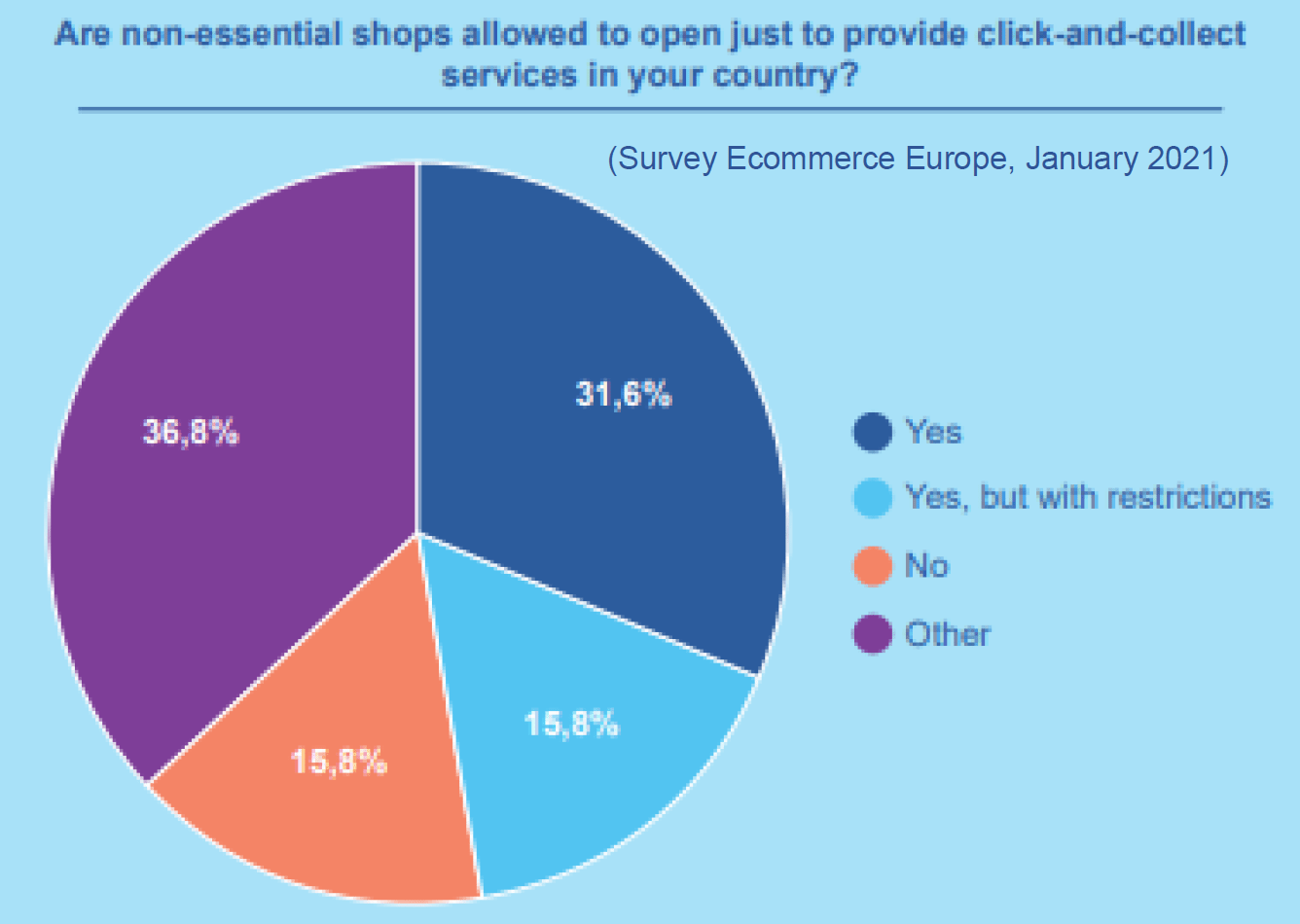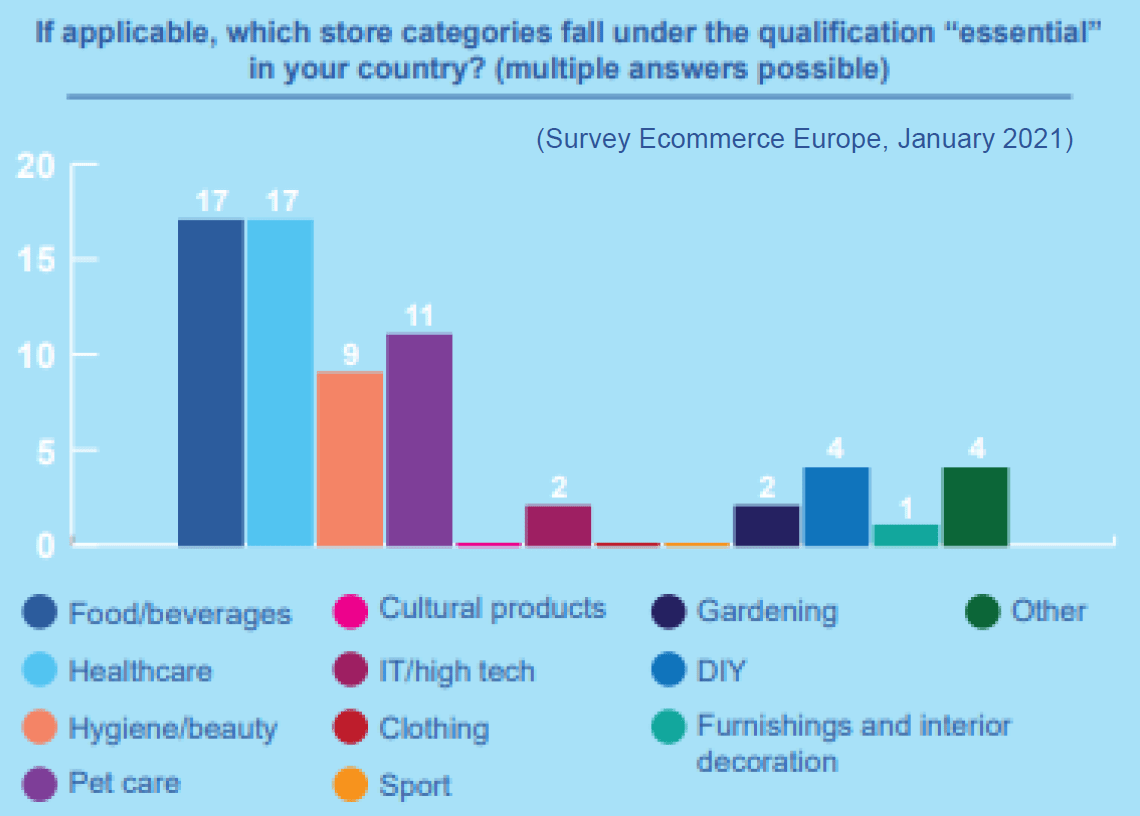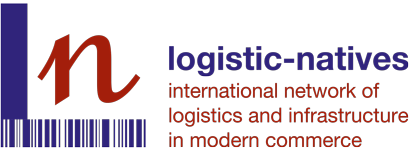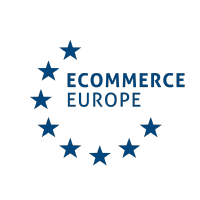Ecommerce Europe – Guide for Safe Click & Collect Introduction
Guide for Safe Click & Collect
Introduction
14. April 2021
The COVID-19 outbreak has had a significant impact on the retail sector. In this difficult last year, e-commerce has proven to be crucial for the continuation of economic activities in Europe. Consumers have turned to e-commerce to continue safely accessing products while their countries implemented very strict, vital lockdown measures.
The crisis has accelerated the digital transformation of many businesses. During the lockdown measures across Europe, many retailers had to close their physical stores and developed an online presence to stay afloat, often making use of seamless commerce solutions such as click & collect to accommodate consumer needs. Ecommerce Europe expects this trend to continue to accelerate and sees the lines between online and offline commerce becoming increasingly blurred, moving towards an omnichannel, seamless commerce sector.
In this context, click & collect provides businesses with an opportunity to continue their operations while keeping staff and customers safe and respecting local social distancing requirements. Unfortunately, businesses across Europe have experienced difficulties in developing and offering consumers click & collect services due to a fragmented approach to click & collect by authorities. With this guide, Ecommerce Europe aims to identify the key challenges businesses have experienced due to fragmentation, offer national and local authorities a clear understanding of the various forms of safe click & collect and recommend European governments to align their approaches to click & collect as much as possible. Finally, several best practices examples are included in this guide to demonstrate the variety of click & collect solutions available to businesses.
Fragmented approach across Europe
 Despite the clear advantages of click & collect for the continuation of economic activities in a country and the survival of brick-and-mortar retailers during lockdown measures, a fragmented approach can still be identified across Europe. In January 2021, Ecommerce Europe published a survey1 on the situation related to COVID-19 and e-commerce in Europe. The findings showed that Member States have adopted varying approaches to the different elements related to click & collect. In January, fragmentation could be observed regarding the rules for click & collect delivery solutions, where such a service was allowed in some countries and limited or even unavailable in others. Additionally, regional fragmentation was observed within some countries with regards to the rules on click & collect.
Despite the clear advantages of click & collect for the continuation of economic activities in a country and the survival of brick-and-mortar retailers during lockdown measures, a fragmented approach can still be identified across Europe. In January 2021, Ecommerce Europe published a survey1 on the situation related to COVID-19 and e-commerce in Europe. The findings showed that Member States have adopted varying approaches to the different elements related to click & collect. In January, fragmentation could be observed regarding the rules for click & collect delivery solutions, where such a service was allowed in some countries and limited or even unavailable in others. Additionally, regional fragmentation was observed within some countries with regards to the rules on click & collect.
In some countries, click & collect is only allowed for store categories qualified as essential. However, no harmonised definition of what constitutes an essential shop exists across Europe. To demonstrate, food and beverages and health categories were qualified as “essential” in the countries of all respondents, and pet care and hygiene products were also considered essential in the countries of about half of the respondents. However, further fragmentation could be found in the EU regarding other product categories. A number of countries extended their “essential” qualification to other product categories, with the DIY sectors being considered essential in France, Ireland, Belgium and Switzerland, the gardening sector in Belgium and Switzerland, the tech sector in France and Italy, and finally the category of furnishings and interior design only in Poland. Whether a given business model belong to a category or another also widely varies from one Member State to the other.

Below you can find some examples of diverging approaches to click & collect across Europe:
• In Romania, click & collect was already used before the pandemic and it continues to be used. There have not been any restrictions on stores implementing click & collect, and authorities have encouraged click & collect pick-up methods, as well as contactless payments.
• In Austria, click & collect was strictly forbidden during the first lockdowns of 2020. In early 2021, it was allowed but regulated in a very complicated manner as pre-ordered goods could only be picked up outside closed premises of the retailers.
• In Denmark, click & collect was already used extensively before the COVID-19 outbreak and continues to be so. When the stores were closed, the government allowed them to use click & collect if they had an entrance or door to the street (open air). However, consumers were not allowed to enter the store premises, and it was not allowed to pay when picking up the goods. Later, when the risk of infection decreased, it became also legal to pay when picking up the goods.
• In Germany, click & collect is organised on a regional level. The German Bundesländer can decide how to handle it and sometimes there are even differences at district level. With the opening of brick-and-mortar shops, the topic of click & collect has become less pressing. However, the fragmentation within the country remains the main challenge. Across the regions, there are different names used for click & collect and different rules apply. For instance, sometimes the payment process has to be done online and in other cases it was possible to make the payment when picking up the product.
• In Ireland, the government has taken a strict stance on click & collect. During the highest level of restrictions, click & collect was heavily curtailed. Only retailers selling what are deemed selling “essential goods” have been allowed to operate physical stores and click & collect services. Furthermore, retailers who sell both essential and non-essential goods, have been permitted only to sell the essential side of their offering to consumers both in-store and via click & collect.
• In France, click & collect cannot be operated in shopping centres subject to mandatory closure while closed stores located outside of shopping centres can still operate click & collect. Mandatory closure obligations are enforced through multiple thresholds targeting total retail spaces over 20, 10 or 5 thousand square meters including warehouses and office space.
How to understand click & collect?
One of the main challenges for businesses is the lack of a common understanding by European governments of what click & collect entails. Businesses across Europe have undertaken great initiatives to operate safe click & collect solutions. To clarify how click & collect services can be understood, this paper identifies a few features that these services have in common:
1. Click & collect is part of seamless commerce, an ongoing development in retail in which the differences between online and offline are increasingly fading. Omnichannel solutions such as click & collect are an important element of the new seamless commerce experience for both businesses and consumers.
2. An essential element of click & collect is that the order is placed at distance, this can for instance be done online or via phone.
3. Click & collect purchases are picked up at the store area, this could include for example the store itself, its entry to the streets or the parking lot.
4. Payment can take place online or at the store area when following safety requirements.
5. During the COVID-19 pandemic, click & collect solutions should follow national or local safety measures. These could be, depending on the local requirements, safety screens, mouth masks and other social distancing obligations. Businesses can adapt their click & collect solutions based on local requirements and can thus always be operated safely.
Examples of how to safely operate Click & Collect
Based on the key principles described above, it becomes clear that click & collect can take many different forms. There are ample possibilities for businesses to arrange click & collect safely. It is therefore important for governments to realise that providing a certain degree of flexibility for businesses in their interpretation of click & collect will not compromise safety. The following elements can be considered:
• Businesses could consider organising timeslots for pick-up, taking into account opening hours of the stores and potential curfew measures in their countries.
• In terms of payment, retailers could choose online payment methods, money transfers, or in store payment methods for which they can respect the safety measures.
• Stores have various options to arrange the preparation and collection of the goods while respecting social distancing. Elements for businesses to consider are for instance:
o Size, type and location of the store,
o External space available such as parking areas,
o Availability of disinfectant, masks and protective screens for consumers and staff,
o Queue control,
o Signage,
o Pick-up lockers,
o …
Best practices
As explained above, safe click & collect can be organised in different ways. This section will provide some best practices examples to demonstrate the diversity of the potential solutions and the innovativeness of businesses.
• IKEA: Contactless click & collect
IKEA Germany developed at the start of the COVID-19 crisis contactless solutions to continue serving its customers but faced 16 constituent states regulating locally click & collect services across Germany. Local authorities did not understand how click & collect services operate in practice and had diverging interpretation of applicable ordinances. To address these issues, IKEA Germany presented local authorities a clear and detailed concept for contactless click & collect services that complied with the applicable legal framework. Online orders and payment processes were the prerequisite for contact-less product handovers.
The pick-up takes place outside the store in a contact-free manner. Consumers collect safely their online order by car, thanks to delivery teams loading their order in their vehicles without any contact. Safety precautions are taken for the handover of the products such as a mandatory obligation for the IKEA staff to wear disposable gloves, cleaning of the handover area every two hours, signage for the customers to be aware of safety distances and timeslots to avoid queues. Prior to collection, the customer receives an e-mail to confirm the pick-up which clearly communicates the procedure and the safety requirements.
IKEA has also implemented contactless click & collect in other European countries. Other innovations include scheduled click & collect providing customers with pre-defined time slots for pick-up, preventing queues and complying with hygiene regulations.
• Sweden: Package Drive Thru
In Sweden, PostNord organised, together with the Stockholm Fair and the Swedish Fair in Gothenborg, a package drive thru for picking up Christmas presents. Outside large exhibition halls, people could pick up their Christmas presents without even having to leave the car. With the large areas that the exhibition halls provided, the Drive Thru could receive and store a large number of packages and at the same time offer safe collection of packages and return of returns.
• Romania: Sameday EasyBOX
EasyBOX is a secured digital locker system that allows flexible pick-up times for online customers. It was launched in 2018 by Sameday courier, an eMAG Group company, and by the end of 2020 it reached up to 1000 units covering 19 Romanian cities. Since 2020, EasyBOX can also be efficiently utilized as a product return point. EasyBOX is currently the delivery method chosen by 4 of the largest retailers in Romania – and became a concept of reference for other click &collect projects nation-wide.
EasyBOX allows for on-site card payments as all locker points are equipped with card readers. The boxes can be accessed by means of a QR code received via email or a numeric code received via SMS. Packages can be picked-up from EasyBOX as early as the morning after placing a product order. According to data gathered in 2020 in those cities where the service is available, more than 25% of orders are placed for EasyBOX pick-up. Estimates show that the percentage is prone to increase to 40% in the near future.
Conclusion: need for a more harmonised approach to click & collect
Diverging regulations and interpretations of click & collect at national and regional levels prevent retailers from implementing these solutions, reducing their resilience to future virus outbreaks and slowing down recovery.
Moreover, the fragmented approach to click & collect across Europe compromises the level playing field within the Single Market, in particular as retail is increasingly digitalising and expanding cross-border. The European digital commerce sector would therefore benefit from a more harmonised approach at European level on click & collect. To facilitate such an approach, Ecommerce Europe aims to contribute to a common understanding of click & collect services via this guide.
Finally, as several countries only allow click & collect solutions for “essential” stores, Ecommerce Europe also recommends European countries to align their approaches and adopt a system for store classification that is as harmonised as possible across Europe. This will ultimately provide further legal certainty for businesses and offer consumers more safe options for shopping.
Here you can download the Click & Collect Guide (PDF)
About Ecommerce Europe
Ecommerce Europe is the sole voice of the European Digital Commerce sector. As a result of joining forces with EMOTA, Ecommerce Europe now represents, via its 23 national associations, more than 100,000 companies selling goods and services online to consumers in Europe. Ecommerce Europe acts at European level to help legislators create a better framework for online merchants, so that their sales can grow further.
Website: www.ecommerce-europe.eu

